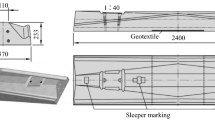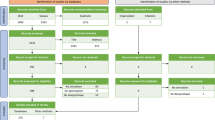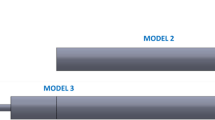Abstract
Based on the traditional Smoothed Particle Hydrodynamics (SPH) algorithm, the linked-list search algorithm combined with the variable smoothing length and square support domain was put forward to improve the calculation efficiency and guarantee the calculation accuracy. The physical process of high velocity fragment impact on a broadside liquid cabin was programmed for simulation. The numerical results agreed well with those of the general software ANSYS AUTODYN, which verifies the effectiveness and feasibility of the numerical method. From the perspective of the outer plate thickness of the liquid cabin, the width of the liquid cabin, and incident angle of the fragment, the influence of these parameters on protective mechanisms was analyzed to provide a basis for protective design of a broadside liquid cabin. Results show that the influence of outer plate thickness is not obvious; therefore, the conventional design can be adopted in the design of the outer plate. The width of the liquid cabin has a great influence on the residual velocity of the fragment and the width of the liquid cabin should be designed to be as wide as possible under the premise of meeting other requirements. There is a certain incident angle in which the velocity attenuation of the fragment is most obvious, and the high-pressure zone near the inner plate is asymmetric. The inner plate of liquid cabin should be strengthened according to the hull form, principal dimensions, and vulnerable points.
Similar content being viewed by others
References
Gurney RW (1943). The initial velocities of fragments from bombs, shells, and grenades. Ballistic Research Laboratory, Aberdeen, Maryland, BRL Report-405.
Houlstonhe R, DesRochers CG. (1987). Nonlinear structural response of ship panels subjected to air blast loading. Computer & Structure, 26(1), 1–15.
Johnson GR, Cook WH (1983). A constitutive model and data for metals subjected to large strains, high strain rates and high temperatures. In Proc. 7th International Symposium on Ballistics, USA, 541–547.
Johnson GR, Cook WH (1985). Fracture characteristics of three metals subjected to various strains, strain rates, temperatures and pressure. Engineering Fracture Mechanics, 1985, 21(1), 31–48
Liu GR, Liu MB (2004). Smoothed Particle Hydrodynamics: A Meshfree Particle Method. Springer, Berlin, German, 1–491.
Libersky LD, Petscheck AG, Carney TC, Hipp JR, Alahdadi FA (1993). High strain lagrangian hydrodynamics-a three dimensional SPH code for dynamic material response. Journal of Computational Physics, 109(1), 67–75.
Liu MB, Liu GR, Lam KY (2006). Adaptive smoothed particle hydrodynamics for high strain hydrodynamics with material strength. Shock Waves, 15(1), 21–29.
Monaghan JJ (1989). On the problem of penetration in particle methods. Journal of Computation Physics, 82(1), 1–15.
Monaghan JJ (1992). Smoothed particle hydrodynamics. Annual review of astronomy and astrophysics, 30, 543–574.
Shin YS, Lee M, Lam KY, Yeo KS (1998). Modeling mitigation effects of watershield on shock waves. Shock and Vibration, 5, 225–234.
Von Neumann J, Richtmyer RD (1950). A method for the numerical calculations of hydrodynamics in shocks. Journal of Applied Physics, 21(3), 232–237.
Wierzbicki T.(1999). Pedaling of plates under explosive and impact loading. International Journal of Impact Engineering, 22(9), 935–954.
Wierzbicki T, Moussa NA (1992). Deformation and rupture of an aircraft fuel tank under hydraulic ram pressure loading. Proceedings of the 63rd Shock and Vibration Symposium, Las Cruces, New Mexico, 2.
Zhang Zhenhua, Zhu Xi, Huang Yuying, Wang Cheng, Liu Runquan (2006). Theoretical research on the defendence of cabin near shipboard of surface warship subjected to underwater contact explosion. Journal of Ship mechanics, 10(1), 113–119. (in Chinese)
Zhang A and Suzuki K (2007). A comparative study of numerical simulations for fluid-structure interaction of liquid-filled tank during ship collision. Ocean Engineering, 34, 645–652.
Zukas JA (1990). High velocity impact dynamics. John Wiley & Sons, New York, 1–920.
Author information
Authors and Affiliations
Corresponding author
Additional information
Foundation item: Supported by the Lloyds Register Educational Trust (the LRET), Key Project of National Natural Science Funds(50939002), and the National Natural Science Fundation of China (50809018)
Aman Zhang is a visiting scholar in University College London, and a professor and PhD supervisor at Harbin Engineering University. His main specialties are ship structural dynamics and dynamics of underwater explosion bubbles.
Furen Ming is a PhD candidate at Harbin Engineering University. His current interests are structural damage and protection of warships, underwater contact explosion, and meshfree methods.
Rights and permissions
About this article
Cite this article
Zhang, A., Ming, F., Cao, X. et al. Protective design of a warship broadside liquid cabin. J. Marine. Sci. Appl. 10, 437–446 (2011). https://doi.org/10.1007/s11804-011-1089-7
Received:
Published:
Issue Date:
DOI: https://doi.org/10.1007/s11804-011-1089-7




